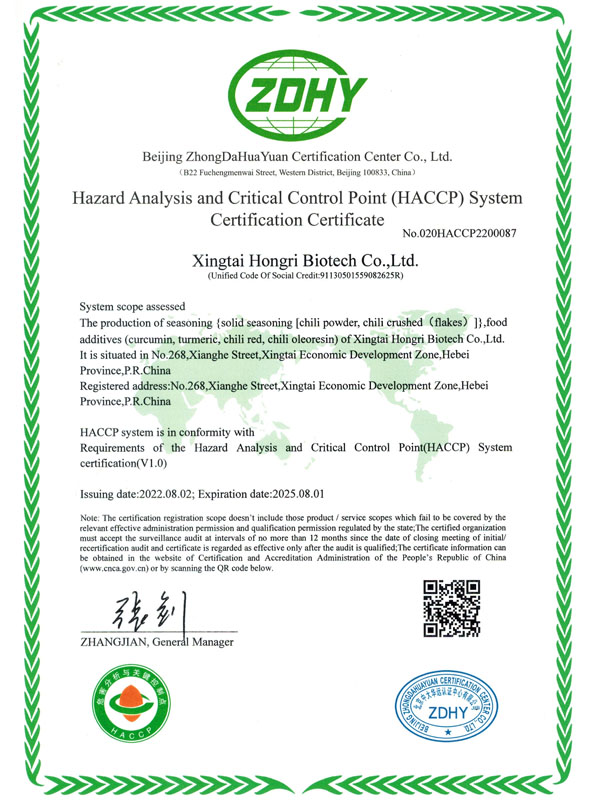- No. 268 Xianghe Street, Economic Development Zone of Xingtai city, Hebei 054001 China
- Byron@hbhongri.cn
Current Trends in Paprika Oleoresin Pricing and Market Analysis
The Market Dynamics of Paprika Oleoresin Prices
Paprika oleoresin, a natural extract derived from the capsicum pepper, has gained prominence in the food industry due to its vibrant color and unique flavor profile. As a natural coloring agent and flavor enhancer, paprika oleoresin is commonly used in a variety of products, from snacks and sauces to processed meats and dairy items. However, the price of paprika oleoresin has seen considerable fluctuations, driven by various factors in the market.
Factors Influencing Prices
1. Supply and Demand Dynamics The primary driver of paprika oleoresin prices is the balance between supply and demand. The global demand for natural food colors is on the rise, as consumers increasingly prefer natural over synthetic additives. With the food industry's shift toward clean-label products, the demand for paprika oleoresin has surged. However, factors such as crop yields and climatic conditions can impact supply, thus influencing prices. A poor harvest or adverse weather conditions in major producing countries like Hungary, Spain, and the United States can lead to shortages and subsequently higher prices.
2. Production Costs The cost of production for paprika oleoresin can vary significantly based on several elements, including labor, processing, and transportation expenses. For instance, rising labor costs in agricultural sectors, especially in developing nations, can increase the overall cost of paprika cultivation, which in turn raises the price of oleoresin. Furthermore, increased energy costs for processing can also contribute to higher prices for end consumers.
3. Quality of Paprika The quality of paprika used for oleoresin extraction has a profound impact on pricing. High-quality paprika, characterized by vibrant color and rich flavor, fetches a premium price in the market. Variations in quality due to different growing conditions, harvesting techniques, and processing methods lead to price discrepancies. As manufacturers aim to ensure their products meet consumer expectations, they may opt for higher-quality oleoresins, thus pushing prices upward.
4. Global Trade Dynamics International trade policies and tariffs can also play a significant role in paprika oleoresin prices. For example, trade disputes, changes in tariffs, or even geopolitical tensions can create uncertainties in the supply chain, affecting pricing. Countries with strong paprika production capabilities, such as Hungary and Spain, may face export restrictions or tariffs that can raise prices in importing nations.
paprika oleoresin price

5. Market Trends and Preferences The culinary trend toward spicier foods and the use of natural ingredients have enhanced the market appeal for paprika oleoresin. This trend is especially evident in the rise of ethnic foods and gourmet cooking, leading to increased demand. Consequently, manufacturers are keen to stock up on paprika oleoresin, creating upward pressure on prices.
Future Outlook
Looking ahead, the market for paprika oleoresin is expected to grow, driven by increasing consumer awareness of health and wellness, along with the favorable shift towards natural ingredients. However, the volatility of prices may persist due to the aforementioned factors, particularly climatic conditions and shifts in consumer preferences.
As investors and manufacturers seek to navigate this dynamic market, strategic sourcing and quality control will be paramount. Engaging in sustainable farming practices and exploring alternative sourcing options may help mitigate risks associated with supply shortages and price spikes.
Conclusion
The price of paprika oleoresin is influenced by a complex interplay of supply and demand factors, production costs, quality variations, global trade dynamics, and evolving market trends. As the demand for natural food ingredients continues to rise, stakeholders in the paprika oleoresin market will need to stay vigilant and adapt to the changing landscape. Understanding these dynamics is crucial for businesses looking to capitalize on the growing trend of natural flavors and colors in the food industry.
-
Turmeric Rhizome Powder: A Golden Treasure from Roots to TableNewsJul.28,2025
-
The Versatile Application Of Crushed Red Hot Peppers: Lighting Up The Red Flames On The Dining TableNewsJul.28,2025
-
The Paprika: A Touch Of Vibrant Red In Color, Flavor, And CultureNewsJul.28,2025
-
Ground Turmeric: A Modern Examination of an Ancient SpiceNewsJul.28,2025
-
Capsicum Liquid Extract: Features, Applications, and ChallengesNewsJul.28,2025
-
Application of Capsicum Liquid Extract in FoodNewsJul.28,2025







